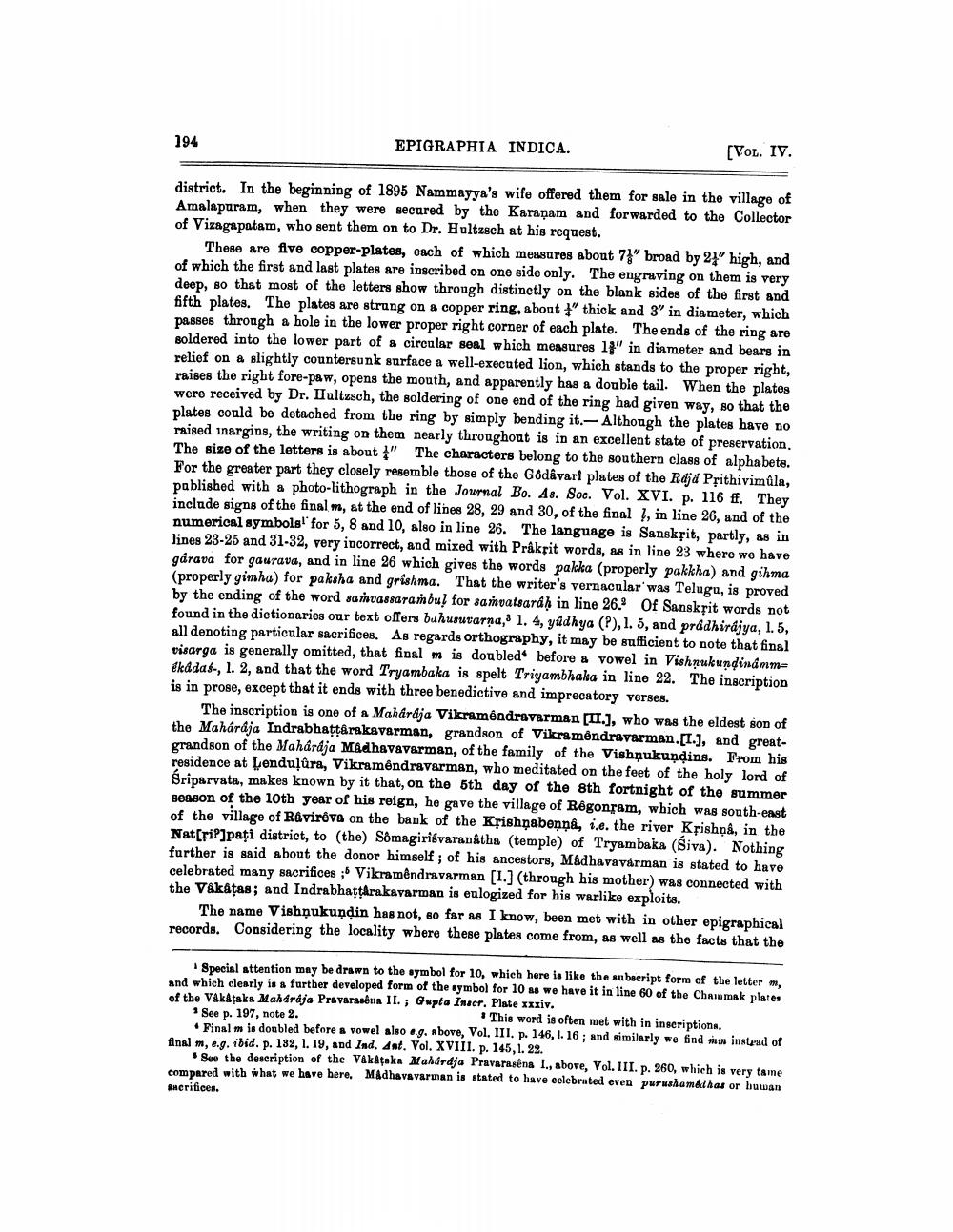________________
194
EPIGRAPHIA INDICA.
[Vol. IV.
district. In the beginning of 1895 Nammayya's wife offered them for sale in the village of Amalapuram, when they were secured by the Karanam and forwarded to the Collector of Vizagapatam, who sent them on to Dr. Hultzech at his request.
These are five copper-plates, each of which measures about 7'broad by 21" high, and of which the first and last plates are inscribed on one side only. The engraving on them is very deep, so that most of the letters show through distinctly on the blank sides of the first and fifth plates. The plates are strung on a copper ring, about " thick and 3" in diameter, which passes through a hole in the lower proper right corner of each plate. The ends of the ring are Boldered into the lower part of a circular seal which measures 1}" in diameter and bears in relief on a slightly countersunk surface a well-executed lion, which stands to the proper right,
raises the right fore-paw, opens the mouth, and apparently has a double tail. When the plates were received by Dr. Haltzsch, the soldering of one end of the ring had given way, so that the plates could be detached from the ring by simply bending it.- Although the plates have no raised inargins, the writing on them nearly throughout is in an excellent state of preservation. The size of the letters is about " The characters belong to the southern class of alphabets. For the greater part they closely resemble those of the Godâvari plates of the Raja Prithivimüla, pablished with a photo-lithograph in the Journal Bo. As. Soc. Vol. XVI. p. 116 ff. They include signs of the finalm, at the end of lines 28, 29 and 30, of the final ], in line 26, and of the numerical symbols!' for 5, 8 and 10, also in line 26. The language is Sanskrit, partly, as in lines 23-25 and 31-32, very incorrect, and mixed with Prakrit words, as in line 23 where we have garava for gaurava, and in line 26 which gives the words pakka (properly pakkha) and gihma (properly gimha) for paksha and grishma. That the writer's vernacular' was Telugu, is proved by the ending of the word samvassarambul for samvatsaraḥ in line 26. Of Sanskrit words not found in the dictionaries our text offers buhusutarna, 1. 4, yudhya (P), 1.5, and prddhirajya, 1.5, all denoting particular sacrifices. As regards orthography, it may be sufficient to note that final visarga is generally omitted, that final m is doubled before a vowel in Vishnukundinamme &kadas., 1. 2, and that the word Tryambaka is spelt Triyambhaka in line 22. The inscription is in prose, except that it ends with three benedictive and imprecatory verses.
The inscription is one of a Mahardja Vikramêndravarman (II.), who was the eldest son of the Maharaja Indrabhattarakavarman, grandson of Vikramêndravarman.[1.], and greatgrandson of the Maharaja Mâdhavavarman, of the family of the Vishņukuņdins. From his residence at Lenduļūra, Vikramêndravarman, who meditated on the feet of the holy lord of Sriparvata, makes known by it that, on the 5th day of the 8th fortnight of the summer season of the 10th year of his reign, he gave the village of Rêgonram, which was south-east of the village of R&virêve on the bank of the Krishnabepni, i.e. the river Krishna, in the Nat[fil]pati district, to (the) Sômagiriśvaranátha (temple) of Tryambaka (Siva). Nothing further is said about the donor himself; of his ancestors, Madhavavarman is stated to have celebrated many sacrifices ;' Vikramêndravarman [1.] (through his mother) was connected with the V&katas; and Indrabhattarakavarman is eulogized for his warlike exploits.
The name Vishnukundin has not, so far as I know, been met with in other epigraphical records. Considering the locality where these plates come from, as well as the facts that the
Special attention may be drawn to the symbol for 10, which here is like the subscript form of the letter m, and which clearly is a further developed form of the symbol for 10 as we have it in line 60 of the Chammak plates of the Vakataka Maldraja Pravarasens II. ; Gupta Inser. Plate xxxiv. See p. 197, note 2.
* This word is often met with in inseriptions, • Finalm is doubled before a vowel also e.g. above, Vol. III. p. 146, 1. 16; and similarly we find in instead of finalm, e.g. ibid. p. 182, 1. 19, and Ind. Ant. Vol. XVIIl. p. 145, 1. 22.
See the description of the Vakataka Maharaja Pravarasens I, above, Vol. III. p. 260, which is very tame compared with what we have here. Madhavavarman is stated to have celebrated even purushamdihas or buwan sacrifices.




